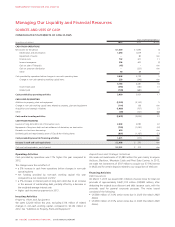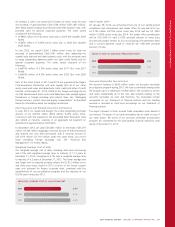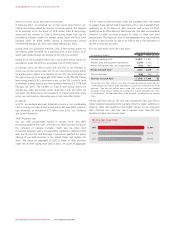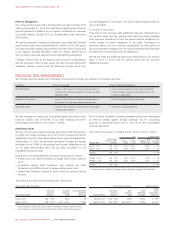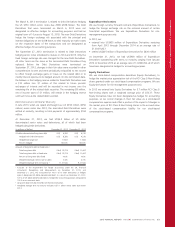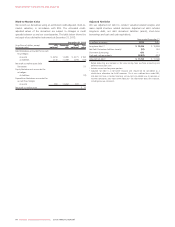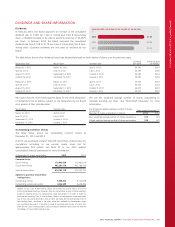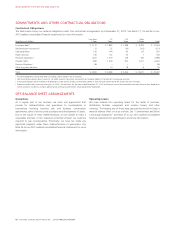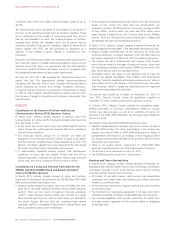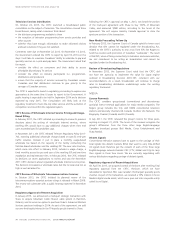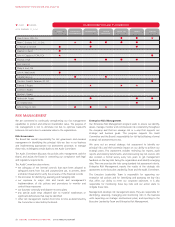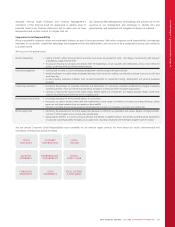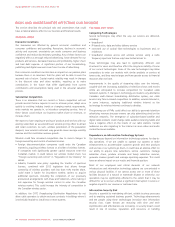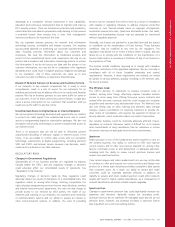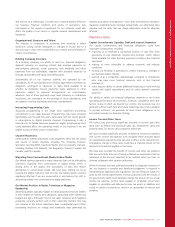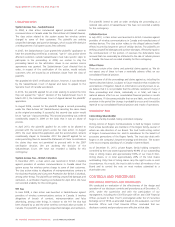Rogers 2013 Annual Report Download - page 72
Download and view the complete annual report
Please find page 72 of the 2013 Rogers annual report below. You can navigate through the pages in the report by either clicking on the pages listed below, or by using the keyword search tool below to find specific information within the annual report.MANAGEMENT’S DISCUSSION AND ANALYSIS
Combined, these limits can enable effective foreign control of up to
46.7%.
The chief executive officer and 80%of the members of the Board of
Directors of the operating licensee must be resident Canadians. There
are no restrictions on the number of non-voting shares that may be
held by non-Canadians at either the holding-company or licensee-
company level. Neither the Canadian carrier nor its parent may be
otherwise controlled in fact by non-Canadians. Subject to appeal to the
federal Cabinet, the CRTC has the jurisdiction to determine as a
question of fact whether a given licensee is controlled by non-
Canadians.
Pursuant to the Telecommunications Act and associated regulations, the
same rules also apply to Canadian telecommunications carriers such as
Wireless, except that there is no requirement that the chief executive
officer be a resident Canadian. We believe we are in compliance with
the foregoing foreign ownership and control requirements.
On June 29, 2012, Bill C-38 amending the Telecommunications Act
passed into law. The amendments exempt telecommunications
companies with less than 10%of total Canadian telecommunications
market measured by revenue from foreign investment restrictions.
Companies that are successful in growing their market shares in excess
of 10%of total Canadian telecommunications market revenues other
than by way of merger or acquisitions will continue to be exempt from
the restrictions.
WIRELESS
Consultation on the Renewal of Cellular and Personal
Communications Services (PCS)Spectrum Licences
In March 2011, Industry Canada released its decisions about the
renewal process for cellular and PCS licences that began expiring at that
time. Key things to note:
• At the end of the current licence term, new cellular and PCS licences
with a 20-year term will be issued to licensees that are in compliance
with all licence conditions.
• The previously existing annual fee of $0.0351 per MHz per
population of the licenced area will continue to apply to all cellular
and PCS licences, including those initially assigned by auction. The
Minister of Industry Canada may review and amend the fees during
the licence term after further consultation with licensees.
• A determination regarding existing research and development
conditions of licence was not released at that time and will be
released separately. A decision has not been made to date, and until
such a time, the current conditions of licence remain in effect.
Consultation on a Policy and Technical Framework for the
700Mhz and 2500-2690Mhz Band and Aspects Related to
Commercial Mobile Spectrum
In March 2012, Industry Canada released its policy and technical
framework for the auction of spectrum in the 700 MHz and 2500–2690
MHz spectrum bands. Key things to note:
• Industry Canada adopted an auction cap for the 700 MHZ (not a set-
aside like in the 2008 Advanced Wireless Services (AWS) spectrum
auction). There are four blocks of spectrum that are considered
“prime”. Large domestic wireless carriers are restricted to a single
block of prime spectrum each, while all other carriers are restricted to
two blocks. Rogers, Bell and Telus are considered large carriers
nationally. SaskTel is considered a large carrier in Saskatchewan, and
MTS is considered a large carrier in Manitoba.
• To encourage rural deployments, single carriers who win two paired
blocks, or two carriers who share their two paired blocks, are
required to use their 700 MHz spectrum to provide coverage to 90%
of their HSPA+ territory within five years and 97%within seven
years. Industry Canada will use Tier 2 licence areas for the 700Mhz
auction. These are 14 large service areas covering all of Canada, and
are generally the same size as individual provinces.
In March 2013, Industry Canada released Licensing Framework for
Mobile Broadband Services (MBS) – 700 MHz Band. Key things to note:
• Industry Canada confirmed that, for the most part, the policy and
technical framework to auction spectrum in the 700 MHz band are
the same as proposed in its March 14, 2012 consultation document.
• The auction will use a combinatorial clock auction (CCA) format,
where bids are made for packages of spectrum licences, rather than
the simultaneous multiple round auction (SMRA) format used in the
past, where bids are made on individual licences.
• Associated entities can apply to bid separately and to have the
auction cap applied individually. These bidders must demonstrate
that they “intend to separately and actively provide services” within a
given licence area for the duration of the spectrum caps (five years
after licensing). Industry Canada has determined that no registered
bidders were associated with each other.
The auction was initially set to begin on November 19, 2013. In
June 2013, Industry Canada moved the application deadline to
September 17, 2013, and the auction start to January 14, 2014.
In October 2013, Industry Canada released its consultation paper,
seeking comments on licencing considerations related to auction
format, rules and processes, as well as on conditions of licence for
spectrum in the 2500–2690 MHz band. The final policy was released on
January 10, 2014.
Key things to note about 2500–2690 MHz spectrum policy:
• Industry Canada adopted a spectrum cap (not an auction cap like in
the 700 MHz auction). No carrier participating in the auction may
possess more than 40 MHz of 2500–2690 MHz spectrum. Rogers is
grandfathered with respect to our holdings in those situations where
we already hold more than 40 MHz of this spectrum. We will not be
required to return spectrum.
• There is no special roll-out requirement for 2500–2690 MHz
spectrum. A general roll-out rule will be determined in the policy.
• The auction is set to commence on April 15, 2015.
• The 2500MHz auction will use Tier 3 licence areas.
Roaming and Tower Sharing Policy
In March 2013, Industry Canada released Revised Frameworks for
Mandatory Roaming and Antenna Tower and Site Sharing, concluding a
consultation initiated in 2012. It sets out the current rules for roaming
and tower and site sharing. Its key terms are:
• All holders of spectrum licences, radio licences and broadcasting
certificates must share towers and antenna sites, where technically
feasible, at commercial rates.
• All licensees were permitted to request roaming from other licensees
at commercial rates.
• The timeframe for negotiating agreements is 60 days, after which
arbitration according to Industry Canada arbitration rules will begin.
• The roaming capabilities must provide connectivity for digital voice
and data services regardless of the spectrum band or underlying
technology used.
68 ROGERS COMMUNICATIONS INC. 2013 ANNUAL REPORT


